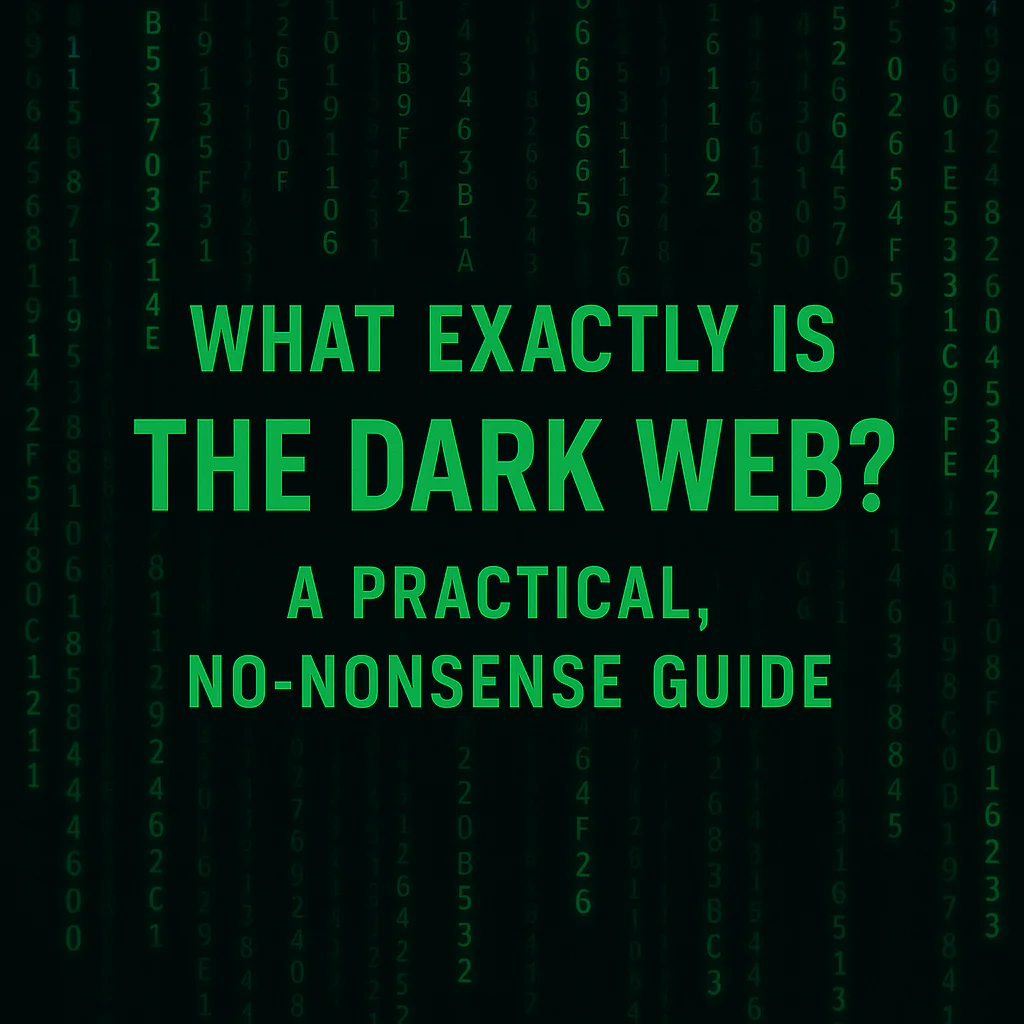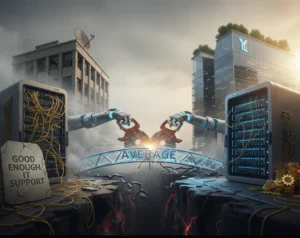What We’ll Cover in This Article: What Exactly Is the Dark Web
- The real difference between the deep web and the dark web (and why most people mix them up)
- How Tor, relays, and “.onion” addresses work—minus the jargon
- Legit uses you probably haven’t heard before (and why they matter)
- How criminals actually operate today and how takedowns happen
- A simple playbook for handling dark-web exposure alerts, including what monitoring can and can’t do
If you’ve Googled “dark web,” you’ve likely found hype, half-truths, and horror stories. This guide gives you the practical version. We’ll explain how the dark web actually works, what’s signal vs noise, and the steps your team can take this week to lower risk—with plain English and real sources.
We provide → technical guidance, not legal advice
Dark web vs deep web: they’re not the same
Most of the internet is deep web—content not indexed by search engines (think intranets, paywalled content, your email inbox). The dark web is a small slice of the internet intentionally hidden and reachable only with specific software and configurations (like the Tor Browser). Put simply: all dark web is deep web, but most deep web is not dark web. Authoritative security explainers make this distinction clear.
How Tor and “.onion” sites work (in plain English)
Tor routes your traffic through at least three volunteer-run nodes (entry/guard → middle → exit) to separate where you are from what you’re doing. When you visit a “.onion” site (an onion service), there’s a twist: traffic never uses an exit node—it stays inside Tor, providing end-to-end encryption between your browser and the onion service. Modern v3 onion addresses are long, random-looking strings that are self-authenticating: the address itself embeds a public key (ed25519), which helps prove you’re talking to the right service.
Advanced—but useful:
- Client authorization lets an onion service operate privately, requiring a pre-shared key to connect. Think of it like a doorman on the front door—no key, no connection.
- Onion-Location header: a normal HTTPS site can announce its official onion mirror so Tor Browser can suggest the safer onion version (you’ll see “.onion available”). This helps defeat phishing and imposter mirrors.
Doceo Pro Tip: If you must access a sensitive portal over Tor, prefer a real onion service (with Onion-Location on the clearnet site) over a random link shared in a forum. It dramatically reduces spoofing risk.
Legitimate uses you might not expect
The dark web isn’t only crime. Journalists, NGOs, and even large platforms expose onion versions of their sites to help users in censored or high-risk regions connect more safely. A notable example: Facebook’s onion service, which moved to a v3 address in 2021 to align with Tor’s security improvements.
Criminal use today: markets, forums, and “leak sites”
Here’s the part most headlines focus on—narcotics markets, stolen data trading, and ransomware “leak sites.” A few realities worth knowing:
- Ransomware groups routinely host data-leak portals on onion services to pressure victims (the so-called “double extortion” model). Independent threat research shows these postings continue even amid takedowns.
- Law enforcement does penetrate and disrupt major platforms. In 2025, Europol coordinated the dismantling of Archetyp Market, one of the longest-running darknet drug markets, with arrests and infrastructure seizures across multiple countries. The FBI/DOJ have run similar global operations (e.g., JCODE/“RapTor”) against darknet drug trafficking.
- It’s not magic anonymity. Many arrests stem from operational-security mistakes (reused handles, misconfigured servers, clearnet endpoints exposed behind onion fronts), infiltration, and cross-border cooperation.
Doceo Pro Tip: Treat “they can’t touch us on the dark web” as a myth. Takedowns in 2024–2025 show that multi-agency, cross-jurisdiction work is routine—and effective.
How your data ends up on the dark web (even if you’ve “never been there”)
Most corporate exposures appear after a third-party breach, credential-stuffing campaign, or stealer-malware infection. Stolen logins, cookies, and tokens are aggregated, bundled, and resold—sometimes in public dumps, often in private channels and invite-only venues. That means what monitoring tools can see is always a subset of the total exposure.
Government and consumer guidance emphasizes mitigation (MFA, password changes, monitoring) rather than chasing removals—because removals are rarely reliable.
Dark web monitoring: what it can—and can’t—do
Useful:
- Early warning. If your credentials or domains appear in known dumps or marketplaces, alerts buy time to reset, revoke, and hunt before attackers act.
- Third-party risk signal. Repeated appearances tied to a vendor can inform your reviews.
Limits (read this twice):
- It’s not comprehensive; much trading happens in closed rooms.
- It’s reactive, not preventative; it doesn’t stop data from leaking.
- Quality varies by provider feeds and takedown speed; treat hits as indicators to act, not as a complete picture.
Pair monitoring with a simple response playbook (below).
Your response playbook for a dark-web exposure alert
When a monitoring alert fires for your domain or an employee account, act like it’s a credible incident precursor. Map your steps to NIST incident response guidance (Rev. 3 published April 3, 2025): prepare → detect/analyze → contain/eradicate/recover → post-incident improvements.
Step-by-step (practical and fast):
- Triage the artifact. What was exposed—username/password, API key, cookie, token? Identify systems and privileges.
- Contain within minutes:
- Force password reset and invalidate active sessions.
- Rotate tokens/API keys and re-enroll MFA if applicable.
- Disable legacy protocols (IMAP/POP, NTLM) for affected accounts.
- Hunt for use: Search logs for unusual access since the likely compromise window (geo/time anomalies, impossible travel, OAuth grants).
- Harden to prevent re-use: Enforce MFA everywhere, set conditional access, and review password reuse across SaaS.
- Communicate & learn: Brief stakeholders, document timeline, and add detections (e.g., first-seen IP, mass-download alerts).
Note:
technical guidance, not legal advice
ROI / Impact: a simple way to frame the value of faster response
In this fictional example:
- You run a 180-person company. A single compromised account leads to 4 hours of disruption across a 12-person team before containment.
- Loaded hourly rate estimate: $65/hour.
- Downtime cost avoided by catching it early (via an alert and a prepared playbook):4 hours × $65 × 12 staff = $3,120 for that one incident.
Now compare that to the cost of enforcing MFA + periodic credential hygiene + alerting. Even if monitoring just accelerates your response, the math favors doing this well.
Things most people don’t know (and should)
- Onion addresses are self-authenticating. That’s why typos are dangerous; the exact string matters.
- Some onion services are private. Without the right key, they’re basically invisible.
- Legit search exists. Ahmia indexes onion services, filtering abusive content and publishing documentation on how it crawls safely.
- Clearnet sites can advertise the “real” onion. Look for the Onion-Location prompt in Tor Browser.
- Takedowns are frequent and coordinated. See 2025’s Archetyp Market dismantling and FBI’s worldwide operations against darknet drug networks.
Quick FAQ
Is visiting the dark web illegal?
No. Using Tor or visiting an onion site is legal in many jurisdictions. Illegal content or activity is the problem. Follow your company’s acceptable-use and legal guidance. (Technical guidance, not legal advice.)
Are “dark web” and “deep web” the same?
No. Deep web = anything not indexed. Dark web = intentionally hidden services that need special software (like Tor).
Can monitoring “remove” my data from the dark web?
Generally, no. Treat alerts as a signal to act—reset, revoke, rotate, and hunt—rather than a promise that someone can delete what’s already spread.
How do law enforcement takedowns actually work?
Through infiltration, infrastructure seizures, and exploiting operator mistakes, often with multi-country teams. See Europol and FBI operations in 2025.
Why would a legitimate company use an onion site?
To provide authenticated, end-to-end access for users in censored regions or to reduce exit-node risks. Facebook has operated one for years (now on a v3 address).
Where Doceo fits (and what to do next)
Doceo’s IT Solutions include Dark Web Monitoring, Identity & Access Management, Endpoint Detection & Response (EDR) with MDR, Backup/DR, and Security Awareness Training—practical controls that reduce real-world risk without the jargon. (Offerings listed in approved order when shown with other pillars.)
Recommended next steps:
- Request an assessment from a Doceo IT Advisor to review your identity controls and monitoring coverage:Let's talk





